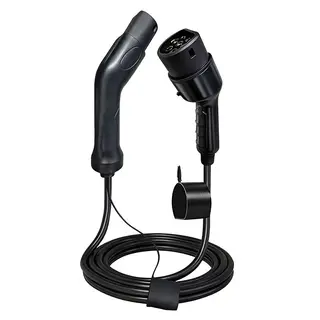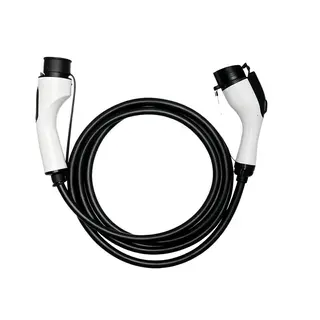With growing environmental awareness and continuous technological advancements, new energy vehicles (NEVs) are gradually becoming a part of our daily lives. More and more people are beginning to recognize and embrace these innovative "green rides". However, many still have questions when it comes to using NEVs, especially regarding charging. Today, we'll take an in-depth look at common issues during the NEV charging process to help everyone better understand and use these vehicles.
Among the charging methods for NEVs, fast chargers, slow chargers, and home chargers are the most common. Each has its own characteristics and is suitable for different usage scenarios.
As the name suggests, fast chargers are charging stations that provide very fast charging. They use direct current (DC) to charge, and the electricity can be directly stored in the power battery. Fast chargers have high power, usually reaching more than 40 kW, and some super fast chargers can reach a peak power of around 117 kW. These chargers put a high load on the power grid and are generally built and maintained by specific operators or car manufacturers. Fast chargers are mainly used in scenarios where quick energy replenishment is needed. For example, during long-distance travel, drivers can quickly charge at service areas and restore the vehicle's range in a short time.
Slow chargers and home chargers use alternating current (AC). They convert AC into DC through the vehicle's onboard charger and store it in the battery. Slow chargers have relatively low power and slower charging speed. Generally, slow chargers provide current at levels between 1–50 A. Home wall-mounted chargers for fully electric vehicles are typically at 32A/220V, which is about 7 kW. The advantage of slow chargers is their low installation cost. With minor modifications to a regular household power supply, they can be installed easily. They are mainly used in scenarios with fixed charging times, such as during work hours or during nighttime off-peak electricity periods. Home chargers are very suitable for nighttime charging, making use of off-peak electricity prices, which is both economical and environmentally friendly.
Charger power is one of the key factors affecting charging speed. Charger power is determined by voltage and current, which can be expressed with a simple physical formula: P = U × I, where power equals voltage multiplied by current. Different operators' chargers have different voltage and current outputs, so the charging power also varies.
Fast chargers typically provide currents (I) of 150–300 A, so their charging power usually exceeds 40 kW. For example, in a previous test using a certain brand of fast charger for the Aion S at SOC 70%, the current was 151 A and the voltage was 364 V. Multiplying the two gives a charging power of 55 kW. Tesla's widely used Superchargers can reach a peak power of about 117 kW. These high-power fast chargers can quickly supply a large amount of energy to the vehicle, greatly shortening the charging time.
Slow chargers typically provide currents of 1–50 A, resulting in relatively low power. Home chargers for fully electric vehicles are around 7 kW, while home chargers for plug-in hybrid vehicles (PHEVs) are usually around 3.3 kW. Public slow chargers commonly have either 3 kW or 7 kW options, with 3 kW being the most common on the market. Although slow chargers charge more slowly, their advantage is low installation cost and suitability for nighttime or long-duration parking.
Although charger power is an important factor affecting charging speed, in reality, charging speed is also influenced by many other factors.
The electrical environment near the charger can affect charging speed. For example, during the summer peak electricity usage, if a fast charger draws power from a nearby public transformer, as the transformer load increases or reaches its peak, the voltage will naturally drop, and the charging speed will slow down. Even if the charger is rated at 7 kW, during peak usage the actual power may be only about 3.1 kW. Therefore, when charging during peak hours, the charging speed may feel significantly slower.
Charging is an interaction between the charger and the electric vehicle. The vehicle's battery capacity, battery temperature, and battery management system (BMS) all affect charging speed. The BMS protects the battery. Typically, the charging power peaks in the middle SOC range. When SOC exceeds 90%, trickle charging is used, reducing current and power to prevent overcharging and overheating, thereby protecting the battery.
PHEV battery capacity is relatively small, generally between 10–15 kWh. Since the electric drive mainly plays an auxiliary role in the vehicle's power system and is mainly used during startup, the charging demand is not as strong as for fully electric vehicles. If fast charging is used, charging from 0–80% can be very fast, but the final 20% is limited by the BMS to prevent overcharging and overheating, so the time to fully charge is not much different from slow charging. Furthermore, considering cost and vehicle architecture, PHEVs have dual fuel and electric drive systems. Adding fast charging would require additional high-voltage electronics, generating heat, increasing cooling requirements, and adding technical costs. Therefore, controlling costs for PHEVs is already challenging; adding a fast charging system would increase costs, further raising vehicle prices and affecting end sales.
When discussing charger power supply, we often hear the terms "three-phase power" and "single-phase power". What is the difference?
Three-phase AC is a form of electrical energy transmission, consisting of three AC voltages of equal frequency and amplitude, each 120° out of phase. Three-phase AC is widely used in industry. Most AC-powered equipment, such as electric motors, use three-phase AC, also known as the three-phase four-wire system. The advantage of three-phase power is high power, capable of supporting high-power equipment.
In daily life, we mostly use single-phase power, also called lighting power. When using lighting power, one phase of three-phase power supplies electricity to the device, and the neutral line, drawn from the three-phase neutral point, serves as the return path. Single-phase power is simple, economical, and suitable for homes and small commercial sites.
Fast chargers require three-phase power because their power demand is too high for single-phase supply. For example, DC fast chargers use three-phase four-wire supply, providing sufficient power with adjustable voltage and current to meet fast-charging requirements. Ordinary slow chargers and home chargers mostly use single-phase input, although some are three-phase. Simply put, single-phase supports low power, while three-phase supports high power. Standard home chargers in China use 220V single-phase with a maximum power of 7 kW. It is also possible to apply for a 380V 30 kW three-phase meter, which includes three phase lines (red), one blue neutral line, and one blue-yellow dual ground line. Any one red phase line, one blue neutral line, and one blue-yellow ground line can form 220V single-phase. Installation depends on local conditions and property permissions.
To help you make the most of your new energy vehicle, here are some practical charging tips:
Plan Your Charging Time Wisely: Try to charge during off-peak hours at night to save on electricity costs. Avoid charging during peak usage periods, as this can slow down the charging speed.
Take Care of Your Battery: Avoid letting the battery drop too low before charging, and don't leave it fully charged for extended periods without use. Regularly check the battery's health to ensure its longevity.
Choose the Right Charging Station: Select a charging station based on your usage scenario. For quick top-ups, use a fast charger. For overnight or long-term parking, a slow charger or home charging station is a better choice.
Pay Attention to Charging Station Maintenance: Regularly check the maintenance status of the charging station to ensure it functions properly. If you notice any faults, contact the operator or maintenance personnel promptly for repairs.
The widespread adoption of new energy vehicles (NEVs) is an unstoppable trend, and the development of charging infrastructure is a key factor in promoting their growth. By understanding the features of fast charging, slow charging, and home charging stations, as well as the various factors that affect charging speed, we can use NEVs more effectively and enjoy the benefits of green travel. This article aims to help readers address common questions encountered during the charging process, making it easier and more convenient to drive a new energy vehicle.



